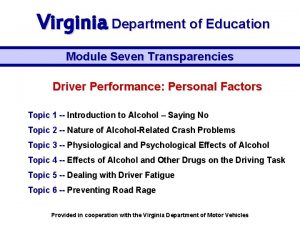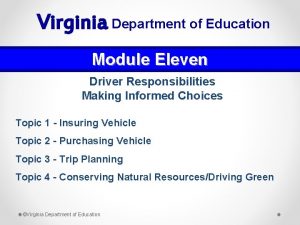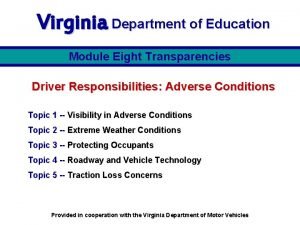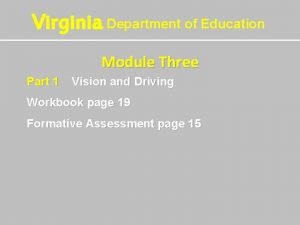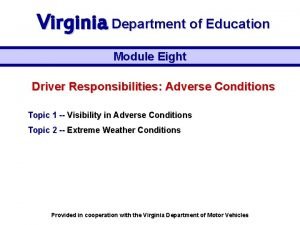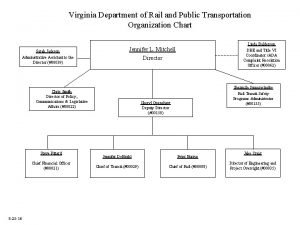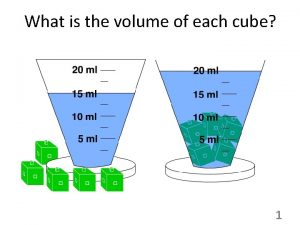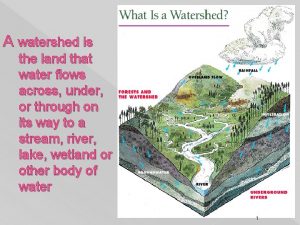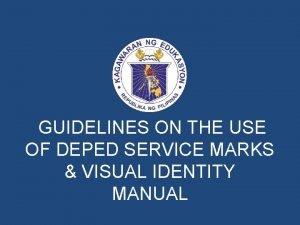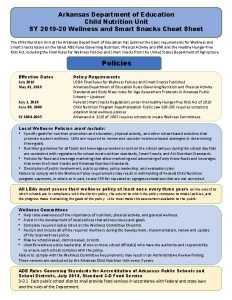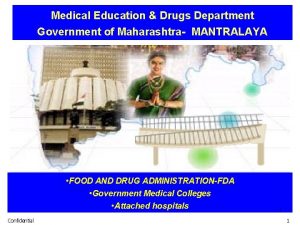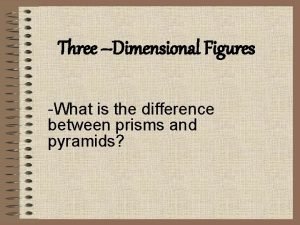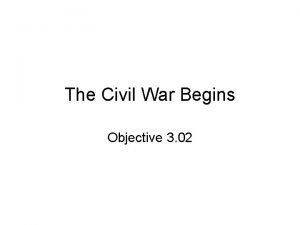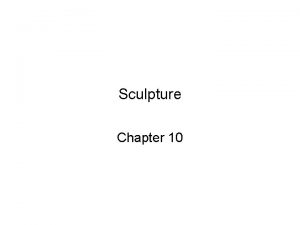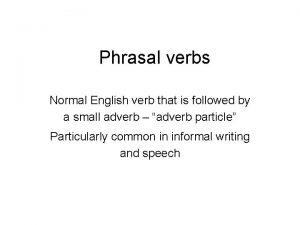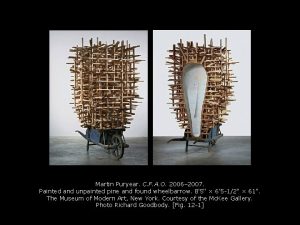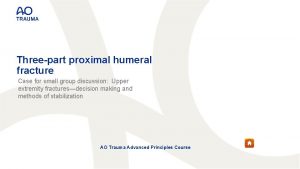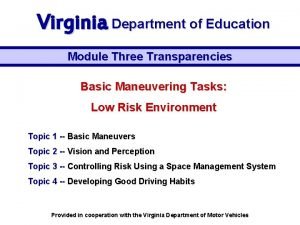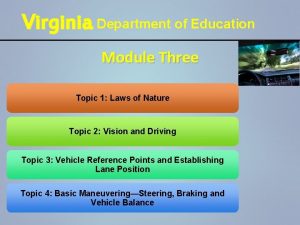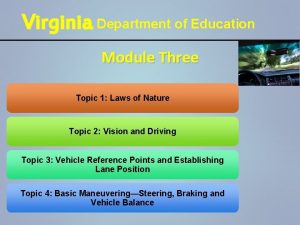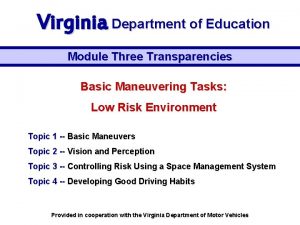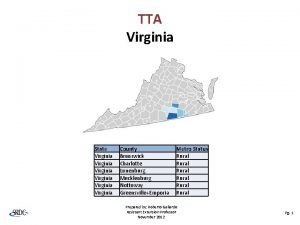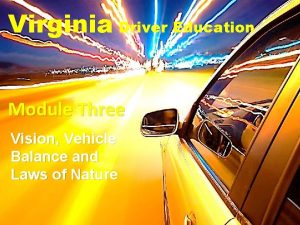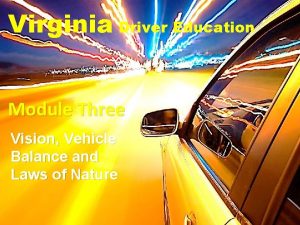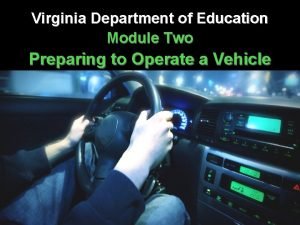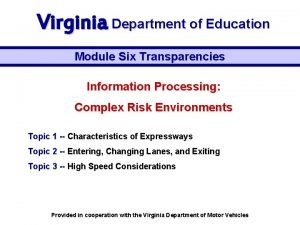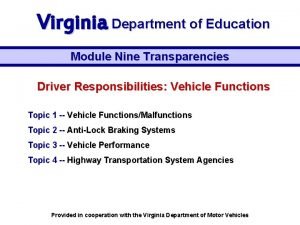Virginia Department of Education Module Three Part 1





































































- Slides: 69

Virginia Department of Education Module Three Part 1 Vision and Driving Workbook page 19 Formative Assessment page 15

Topic 2 - Vision and Driving Drivers base about 90% of all driving decisions on what they see, and 10% on what they hear or feel • Drivers must be able to look far enough ahead to make good decisions about speed, lane position, signs, signals, markings, and potential hazards • Drivers must be able to see near and far--close enough to read the speedometer, and far enough ahead to see/adjust for hazards

Effective Use of Visual Fields The Three Visual Fields • Focal Vision Visual Lead, Targeting, Signs, Signals • Central Referencing, Path of Travel • Peripheral Vision Motion and Color Changes

The Focal Vision Area Located at the center of the central vision area, the fovea is a small part of the retina and is responsible for our highest visual acuity (Focal Vision)

Central Vision Area (Inner Fringe) An area 35 to 38 degrees around focal vision used for: • Referencing Vehicle Position to Roadway • Viewing Path of Travel

CENTRAL VISION AT NIGHT The human eye’s field of vision is much smaller without the help of natural light Depth perception, visual acuity, and color recognition are all compromised at night Minimize glare by looking at the bottom right of the road to avoid approaching headlights Keep it dark in the car Slow down to give yourself longer to react

Peripheral Vision Approximately 90 of vision to each side Increases total field of vision to about 180 -190 and is used to see: • Objects to the side • Movement and color changes to the side

Peripheral Vision and the Driving Task Drivers use peripheral vision to: • See color and object movement • See signal changes, road signs, warning lights on the dashboard • Monitor traffic • Stay within the lane

Night Time Peripheral Vision • Is reduced dramatically due to lack of light to retina and glare • While Focal and Central Vision are also reduced, they become more critical for searching for problems

Vision is Affected by • • Speed Fatigue Drugs Poor weather Darkness Glare Inattention • Smoke • Age • Dirty Windshield • Poor Windshield Wipers • Poor night vision • Night Blindness

Depth Perception Need both eyes to judge the distance between two objects Depth perception allows you to: • judge gaps in traffic when turning, merging, or passing • judge distance when approaching a vehicle or obstruction

Poor Depth Perception Stop too far from the stop line or intersection Stop too close to vehicles ahead Move into gaps that are too small Look for gaps that are larger than needed to perform a maneuver Follow other vehicles at unsafe following distance Hit parked cars when parking Have “close calls” when entering traffic, passing, etc.

As speed increases • • • Central vision decreases and blurs Peripheral vision decreases Changes in steering exaggerate vehicle movement VISION FIELDS NARROW

Ways to Improve the Vision Fields • Clean windows—inside and out • Clean lights—be sure they work • Check defroster and wiper blades • Remove any objects that interfere with vision • Adjust mirrors properly • Keep sunglasses, flashlight, windshield scraper in vehicle

Virginia Department of Education Part 2 Module Three Path of Travel

Line of Sight Line-of-sight is the distance you can see in your path of travel

Line-of-Sight (LOS) Restrictions Vision is blocked, speed and position adjustments may be needed until LOS is restored

Path-of-Travel The space the vehicle will occupy while traveling to the target area

Examples of Path-of-Travel Restrictions Space is not available for the vehicle Narrow lane and no shoulder Vehicle stopped or blocking intersection

“Target” Far Ahead in the Path of Travel Identify the target in this driver’s path of travel A “Target” is an object or place far ahead in the center of your path of travel

Target AREA Provides the BIG Picture The Target area is the area drivers must scan to the left and right of the target Target Area

Advantages of Targeting • Easier to track vehicle in a straight line • Driver looks far ahead of the vehicle, and at the same time gathers information close to the vehicle • Driver can plan ahead to better manage risks • Targeting develops visual skills essential for managing traction loss and steering control

Virginia Department of Education Module Three Part 3 Footprint Page 15 #2 Workbook Definition: The Pavement Around Your Vehicle You Cannot See From the Driver’s Seat Activity

Virginia Department of Education Module Three Part 4 Reference Points and Lane Positions Pages 16 -17 Workbook Activity

Standard Vehicle Reference Points Front Limitation You will need to know where the front bumper of your vehicle is when you are: • At intersections • At a stopped position • When parking • At a crosswalk STOP LINE

Standard Vehicle Reference Points Front Limitation To position 3 -6 inches from the line in front of your bumper, stop when your line of sight runs under the side view mirror to curb in front Reference point Reference Point Line of sight

Standard Vehicle Reference Points Front Limitation When you look at the curb line it appears to line up with the side view mirror

Standard Vehicle Reference Points Rear Limitations – How They are Used LEFT When backing to know where your rear bumper is RIGHT When backing around a corner, it’s the pivot point for turning, such as backing into a perpendicular parking space

Standard Vehicle Reference Points Rear Limitations LEFT When you look back over your left shoulder, the curb or line appears to be in the middle of the left rear window RIGHT When you look back over your right shoulder, the curb or line appears to be near the rear window corner

Standard Vehicle Reference Points Left-Side Reference Point Used for: • Lane Position 2 • Preparing for a left turn • Determining position for parking on the left side of a one-way street (3 -6 inches from the curb or line)

Standard Vehicle Reference Points Left Side Reference (3 -6 Inches) When you look at the curb, pavement line, or edge of the road, it appears to line up about one foot in from the left edge of the hood

Standard Vehicle Reference Points LEFT Reference Point 6 inches from line or median • • • 3 feet from line or median Relates a part of the vehicle to some part of the roadway Know your vehicle placement within a lane at all times Maneuver in confined places

Standard Vehicle Reference Points Right Side Reference Points Are Used: • To know where the curb or line is located • For Lane Position 3 • For parking

Standard Vehicle Reference Points Right Side Reference Point Your vehicle is 3 -6 inches from the curb, pavement line or edge of the road when the line appears near the center of the hood

Standard Vehicle Reference Points RIGHT Reference Point 3 feet from line or curb • • • 6 inches from line or curb Relates a part of the vehicle to some part of the roadway Know your vehicle placement within a lane at all times Maneuver in confined places

Standard Vehicle Reference Points To Position Vehicle Three Feet Away When you look at the curb, pavement, or edge of the road, it appears to line up with the middle of the right- half of the hood

Standard Vehicle Reference Points Right Side -- Three Feet Away • To position for a right turn or for • Lane Position 1

REFERENCE POINT REVIEW Limitation Front Rear Left 3”-6” from curb Right 3”-6” from curb Reference Point Side view mirror Center door post Left Hood line Center of car (inspection sticker) Diagram

Using Lane Position to Maximize Line Of Sight • Select the lane position that gives you the best line of sight and safest path of travel • Lane positions are based upon an average lane size of 12 -feet wide, and a vehicle 6 -feet wide

Lane Position 1 Workbook Letter A page 17 2 -3 Feet Positioned in the center of lane with an equal buffer of space on either side

Lane Position 2 Workbook Letter B page 17 3 -6 Inches Allows for 6 feet of space to the right of the vehicle. Used to prepare for a left turn or when avoiding a problem to the right of the vehicle.

Lane Position 3 Workbook Letter D page 17 3 -6 Inches Allows for 6 feet of space to the left of the vehicle. Used to prepare for a right turn or when avoiding a problem to the left of the vehicle.

Lane Positions 4 (Letter C) and 5 (Letter E) 4 5 Lane positions 4 and 5 – straddling the line to avoid a problem within a lane

Virginia Department of Education Module Three Part 5 Acceleration, Braking Vehicle Balance Formative Assessment - Pages 13 -14 Workbook Balloon Activity

Acceleration Techniques 1. Progressive, Smooth Acceleration • Heel pivots foot from the brake to the accelerator • Gently apply pressure to the accelerator pedal to gradually increase speed to minimize backward pitch and maintain vehicle balance

Braking Techniques Smooth braking technique: Is a trait of a skilled driver Saves wear and tear on the brake system and tires

Methods to Reduce Speed Release the Accelerator • Most frequently used method to slow vehicle speed • Gradually reduce pedal pressure to avoid abrupt changes in speed

Methods to Reduce Speed 2. Controlled Braking - When releasing the accelerator is not enough • Check the rear view mirror • Release accelerator and apply smooth, steady pressure on the brake pedal • For a smooth STOP, gently ease off the brake a few seconds before stopping to reduce the vehicle’s weight shift so the car does not pitch forward then backward during the final phase of stopping

Methods to Reduce Speed (cont) 3. Threshold Braking in an Emergency Slows the vehicle as quickly as possible without locking brakes or losing traction • Release accelerator while checking traffic behind • Exert forceful pressure on brake pedal and you will feel the vehicle weight shift forward • If you feel the wheels begin to slide, ease the pressure on brake pedal so the tires can begin rotating again

Methods to Reduce Speed (cont. ) 4. Trail Braking – Used for Sharp Turns Occurs at the transition point where you slightly reduce the brake pedal to allow vehicle to begin to regain speed applying the accelerator pressure on the before

Trail Braking 1. Use controlled braking prior to reaching the curve 2. Begin easing off brake, and trail brake with very light pressure until halfway through the turn, 3. Accelerate out of the turn

ANTI-LOCK BRAKING SYSTEM (ABS) WORKBOOK PAGE 65 ABS allows maximum stopping force without locking up the brakes (skidding) If standard brakes are applied too hard, the wheels "lock" or skid, and you lose steering control.

Anti-Lock Braking System (cont) If steering control is lost, the vehicle skids in a straight line wherever it is going ABS is an anti-lock/anti-skid brake system that allows the driver to steer during hard braking

Anti-Lock Braking System (cont. ) • The ABS warning will come on when there is a problem with either the ABS brake system, normal brake system, or the brake fluid is low in the master cylinder or the ABS brake system • To find out if a vehicle is equipped with ABS, turn on the ignition and check the instrument panel for the ABS indicator light

Practice Activating ABS In a parking lot, go 20 -25 mph and execute an emergency stop to engage ABS Keep your foot firmly on the brake even when you feel the brake pulsate and/or hear noise This computerized pumping action can pump the brakes up to 15 times per second

Myths about ABS There are fewer fatal crashes for cars equipped with ABS False, some drivers panic and/or release the brake when it pulses • Don’t use ABS brakes on a slippery surface False, ABS shortens stopping distance and improves control on a slippery roads

Maintaining Vehicle Balance Vehicle balance is the distribution of the weight of the vehicle on the tires Optimum balance is reached when the vehicle is not moving or is moving in a straight direction at a constant speed As soon as the vehicle accelerates, brakes, or turns, the balance is changed and the weight transfer changes the size of the tire patches

Pitch, Roll, and Yaw Worksheet on Vehicle Balance Pitch, Roll, and Yaw are three axes running through a vehicle’s center of gravity Yaw Pitch Roll

Vehicle Pitch Vehicle’s weight shifts backward or forward Backward Pitch: Changing Vehicle Load from Front to Rear Forward Pitch Changing Vehicle Load from Rear to Front • Accelerating • Releasing the accelerator • Releasing the brake • Braking

Vehicle Roll: Vehicle’s weight shifts to the tires located on one side of the vehicle Which direction is this driver steering to cause this weight shift? What causes a vehicle roll over?

Vehicle Yaw: Fishtailing No Yaw Vehicle’s rear tires lose traction and weight shifts to one side while opposite rear wheel moves toward front of vehicle Yaw

Steering For Balance And Control • Sit at a safe distance from the wheel • Use a balanced hand position • As speed increases, steering input is reduced for turns and other maneuvers Photo courtesy of ADTSEA

Changes in Speed Affects Balance and Control • Pushing or releasing the accelerator pedal is the primary method to adjust the speed of a vehicle • Changes in speed causes weight shifts to front or rear tires • Increases in speed with steering adjustments causes significant shifts in the vehicle’s weight

Braking Affects Balance and Control How does braking affect balance and control in a front or rear-wheel drive vehicle?

Effect of Hard Braking and Steering • Applying hard braking causes weight to shift sharply to the front tires • If the weight shift exceeds available traction, the tires will skid and steering control is lost (under steer)

Steering and Balance Accelerating, braking, or steering shifts the vehicle’s weight from tire to tire and affects vehicle balance and control Describe the driver’s action and how is it affecting this vehicle’s balance?

Vehicle Load Vehicle load capacity includes the combined weight of people, liquids and cargo that the vehicle is designed to safely handle

Effect of Load On Vehicle Balance What could occur if the driver of this vehicle made a quick steering maneuver? Photo courtesy of AAA Foundation

Worksheet on Vehicle Balance ROLL Definition How does it happen? How do you prevent/reduce it? Consequences if not prevented Side to side Weight shifts from side to side Ex: on a curve Slow down to a safe speed for the road and conditions Roll over PITCH Front and Back Accelerate too quickly (pitch back) Brake too hard (pitch forward) Smooth acceleration and smooth braking (braking – to – a stop) People or objects in car fly around Brakes wear faster YAW Fishtail Rear tires lose traction Ex: hydroplaning, ice/snow Accelerating and braking gradually on non-dry surfaces If happens take foot off brake and accelerator and steer where you want to go Loss of control
 Module 10 topic 2 vehicle malfunctions
Module 10 topic 2 vehicle malfunctions Module 7 topic 3 drivers ed
Module 7 topic 3 drivers ed Curriculum guide for driver education in virginia module 11
Curriculum guide for driver education in virginia module 11 Curriculum guide for driver education in virginia module 8
Curriculum guide for driver education in virginia module 8 Curriculum guide for driver education in virginia module 3
Curriculum guide for driver education in virginia module 3 Curriculum guide for driver education in virginia module 3
Curriculum guide for driver education in virginia module 3 Drivers ed module 5 topic 3
Drivers ed module 5 topic 3 Module 8 topic 1
Module 8 topic 1 Seo northern virginia
Seo northern virginia Virginia department of agriculture and consumer services
Virginia department of agriculture and consumer services Virginia department of historical resources
Virginia department of historical resources Virginia department of rail and public transportation
Virginia department of rail and public transportation Virginia department for the blind and vision impaired
Virginia department for the blind and vision impaired C device module module 1
C device module module 1 D
D What are the three major watersheds in virginia
What are the three major watersheds in virginia What are the three major watersheds in virginia
What are the three major watersheds in virginia What are the three major watersheds in virginia
What are the three major watersheds in virginia Tiffany taylor georgia department of education
Tiffany taylor georgia department of education Amy williamson iowa
Amy williamson iowa Oklahoma alternative placement program
Oklahoma alternative placement program School education and literacy department
School education and literacy department Peos
Peos Gauteng north district
Gauteng north district Gde vision and mission
Gde vision and mission Gde mission and vision
Gde mission and vision Department of education single sign on
Department of education single sign on Department of higher education and training
Department of higher education and training Ohio tpes
Ohio tpes Indiana department of education
Indiana department of education D.o. 31 s. 2019
D.o. 31 s. 2019 Department of education region 3
Department of education region 3 Ohio department of higher education
Ohio department of higher education Republic of the philippines department of education
Republic of the philippines department of education Arkansas department of education child nutrition unit
Arkansas department of education child nutrition unit Arkansas child nutrition unit
Arkansas child nutrition unit Republic of the philippines department of education
Republic of the philippines department of education Early childhood directorate
Early childhood directorate Department of education
Department of education Oklahoma 3rd grade math standards
Oklahoma 3rd grade math standards Reliant capital solutions department of education
Reliant capital solutions department of education Principal certification oklahoma
Principal certification oklahoma Idoe science of happiness
Idoe science of happiness Nebraska department of education nutrition services
Nebraska department of education nutrition services Sindh education and literacy department
Sindh education and literacy department Michigan department of education teacher certification
Michigan department of education teacher certification Medical education and drugs department
Medical education and drugs department Edudel student module
Edudel student module Part whole model subtraction
Part whole model subtraction Part to part ratio definition
Part to part ratio definition Part part whole
Part part whole Part by part technical description example
Part by part technical description example Layout dispense bar diagram
Layout dispense bar diagram The phase of the moon you see depends on ______.
The phase of the moon you see depends on ______. Two way anova minitab 17
Two way anova minitab 17 Are three-dimensional figures that enclose part of space
Are three-dimensional figures that enclose part of space William tecumseh sherman total war
William tecumseh sherman total war Corporate wars wall of influence
Corporate wars wall of influence Three main parts of an essay
Three main parts of an essay A two or three part verb
A two or three part verb The function of seeds
The function of seeds Olafur eliasson the weather project
Olafur eliasson the weather project What is journalizing transactions in accounting
What is journalizing transactions in accounting Thesis statement
Thesis statement Three part fracture
Three part fracture Part three 1984
Part three 1984 The hobbits and orcs problem
The hobbits and orcs problem Othello act 3 summary
Othello act 3 summary In three minutes write three things you did yesterday
In three minutes write three things you did yesterday Orange, diamond-shaped signs warn the motorist of:
Orange, diamond-shaped signs warn the motorist of:

